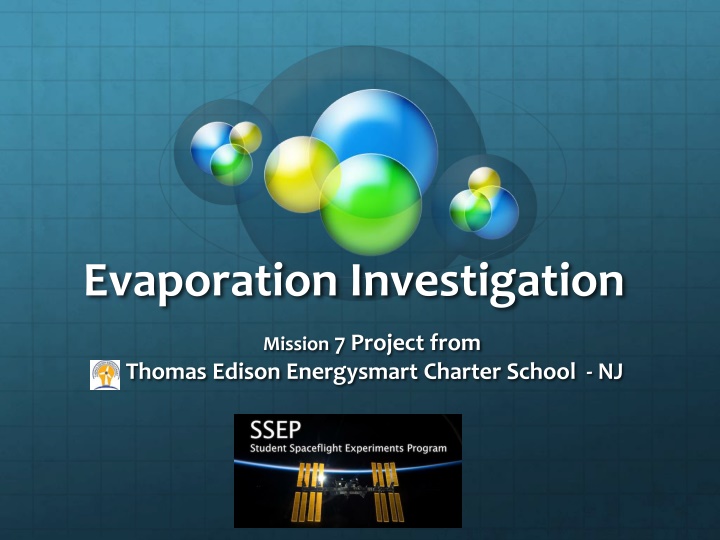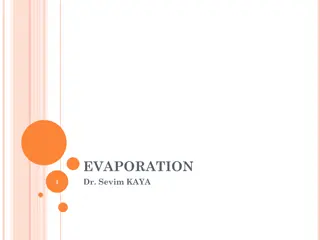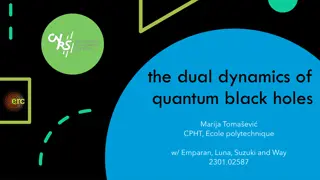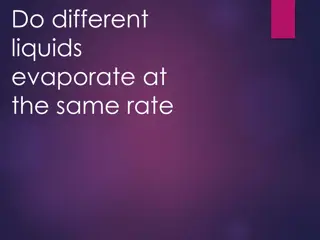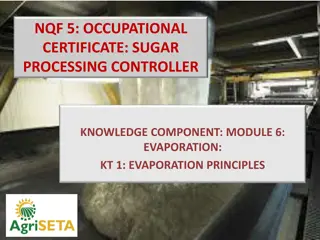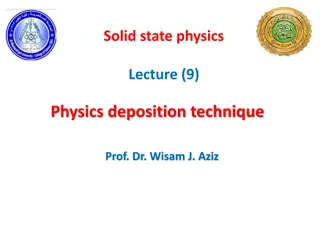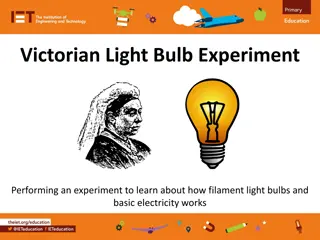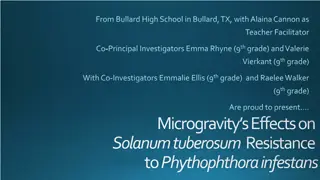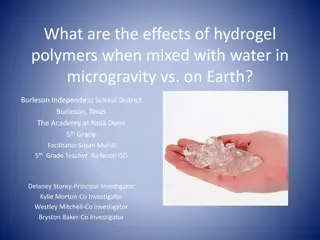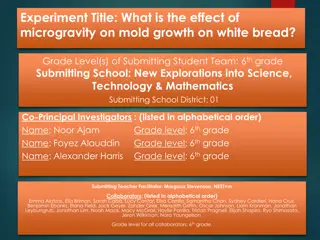Microgravity Evaporation Study by Thomas Edison Energysmart Charter School
Evaporation Investigation Mission 7 Project led by students from Thomas Edison Energysmart Charter School in NJ explores the effects of microgravity on water evaporation from the human body and foods. The study aims to understand differences in evaporation in space and on Earth to assess food freshness and sustainability for future space colonization. Using common household materials, the experiment simulates water evaporation by manipulating humidity levels. Analysis involves measuring the weight of evaporated water to draw conclusions.
Download Presentation

Please find below an Image/Link to download the presentation.
The content on the website is provided AS IS for your information and personal use only. It may not be sold, licensed, or shared on other websites without obtaining consent from the author.If you encounter any issues during the download, it is possible that the publisher has removed the file from their server.
You are allowed to download the files provided on this website for personal or commercial use, subject to the condition that they are used lawfully. All files are the property of their respective owners.
The content on the website is provided AS IS for your information and personal use only. It may not be sold, licensed, or shared on other websites without obtaining consent from the author.
E N D
Presentation Transcript
Evaporation Investigation Mission 7 Project from Thomas Edison Energysmart Charter School - NJ
Evaporation Investigation Co-Principal Investigators : Kareena Kapadia - 5th Grade Meghan Gajula - 5th Grade Natalia Arevalo - 5th Grade Franklin Park NJ Mrs. Ghosh, TEECS - Teacher Facilitator Mr. Yildiz - Principal Mr. Nagaraju Gajula - Parent Advisor Mission 7
The Question Does microgravity have any effect on the rate of water evaporation from our human body and foods? We know water evaporation depends on many factors, mainly: Relative Humidity of the air Temperature of the air and the water Surface area of the water Pressure on the water Velocity of the wind/air over the water
Rationale Evaporation constantly happens Water evaporates from everything, from fruits to vegetables to our body Astronauts live in space for long periods of time It is important to understand how evaporation differs in microgravity It is essential to know how long fruits and vegetables will stay fresh in space for future colonization
Materials We will use common materials we find in our household to conduct this experiment Packets of non saturated silica gel Water Cotton Small cups to weigh silica gel, cotton, and water Water dropper, scissors and tweezers Weighing scale that measure to nearest hundredth of a gram
Experiment In our experiment, we will simulate water evaporation, and use humidity as a driver In the FME, we will place cotton containing a few drops of water, and Silica Gel The silica gel will absorb moisture from the air within the FME, and forces the water from the cotton to evaporate We will run this investigation in ISS and on earth
Analysis Using the recorded data, we will calculate the weight of water evaporated by weighing different materials. Water evaporated is Difference between weight of water before and after OR Difference between weight of silica gel before and after
Conclusion Outcome 1: Evaporation rate is different between ISS and Earth Microgravity has some effect on water evaporation Outcome 2: Evaporation rate is same between ISS And Earth Microgravity has NO effect on water evaporation
Supported By: We are thank full to all the members of the community, sponsors and supports of SSEP for making this happen. TEECS staff administration and students TEECS PTO NJ Department of Education Smithsonian National Air and Space Museum Washington DC Center for the Advancement of Science in Space (CASIS) Subaru of America, Inc., Big Kid Science NASA Nebraska Space Grant Consortium Carnegie Institution of Washington Carnegie Academy of Science Education
